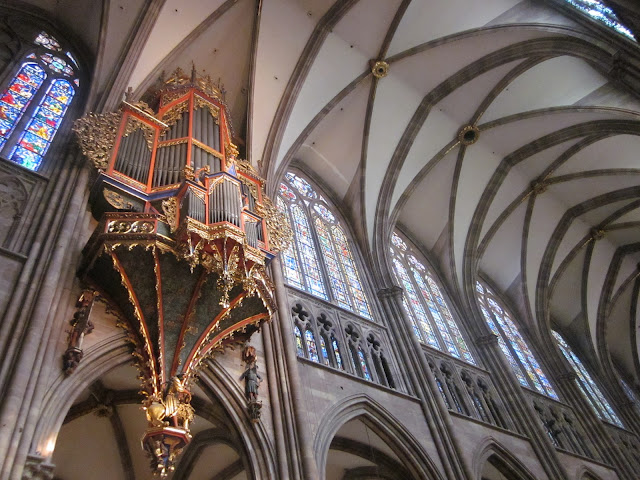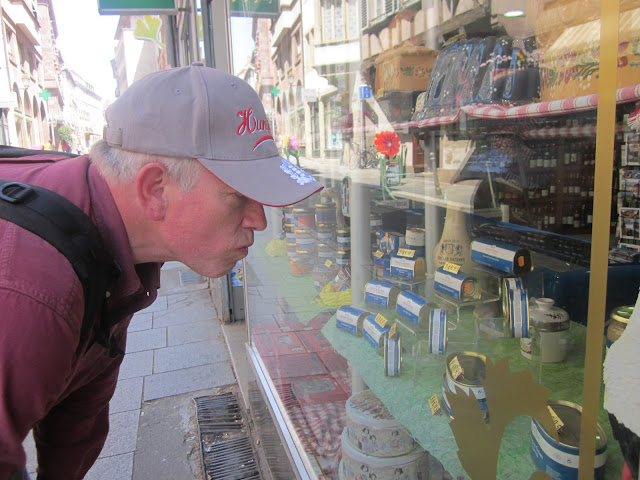The dominant building of the Strasbourg skyline is the Strasbourg Cathedral, built between 1176 and 1439. At 466 feet tall, it was the tallest building in the world until 1874. Now it is the sixth tallest church in the world, but it is the tallest building completed in the Middle Ages that is still standing.
It is very difficult to get a decent picture of it because of how surrounding buildings have crept ever closer to its walls through the centuries:
An aerial view from the internet shows what I mean:
The magnificent High Gothic front of the cathedral has thousands of intricate figures carved into its pink sandstone facade:
The interior is equally dramatic, rising over three stories and with an unusual 14th century pipe organ suspended high up on one wall between the stained glass windows:
The cathedral contains a famous astronomical clock. It's not quite as spectacular as the one we saw in Prague, but it has its own charm. It was completed in 1571 by a team of sculptors, painters, mathematicians, and watchmakers. It ticked regularly along until one day in 1788 when it suddenly stopped. After studying it for years, a self-taught Alsatian clockmaker was able to rebuild the mechanism. It was restarted in 1842 and has ticked on since then.
The cathedral has more than 4,600 panels of stained glass windows that date back to the 12th to 14th centuries. There are three horizontal levels of windows, a rather unusual configuration that allows for more light than is typical for a Gothic interior. The fragile windows were removed during World War II and stored in 74 crates in a salt mine. That must have been one giant jigsaw puzzle!
The very unique rose window, 45 feet in diameter, does not depict a religious scene. Instead, it shows sheaves of wheat that indicate the city's economic power. I remember Mom, who knew a surprising amount about religious architecture, telling us as we traveled together through Germany that some cathedrals were "built for God" and some were "built for power." I wonder if the Strasbourg Cathedral was some of both. Because of the lighting, I just couldn't get a good picture of the rose window, so I borrowed these from Wikipedia:
We were really on a spire-climbing kick on this trip. Whenever we had the opportunity, we climbed. I think it is one of the things that saved me from a premature Death-Caused-By-Gelato. The Strasbourg Cathedral has a mere 326 steps. (We would be climbing an even taller spire a few days later.)
There was a nice resting area about mid-way up that gave us a chance to escape the claustrophic stairwell.
The famous German writer Goethe described this cathedral as "a sublimely towering, wide-spread tree of God," and French author Victor Hugo wrote that "the true triumph of this Cathedral is the spire. It is a veritable tiara of stone with its crown and its cross. It is a gigantic and delicate marvel." I can't imagine what this building must have looked like to 15th century Europeans. Even today, it can still be seen from miles away.
Next: Moving on . . . to Utah!
It is very difficult to get a decent picture of it because of how surrounding buildings have crept ever closer to its walls through the centuries:
An aerial view from the internet shows what I mean:
The magnificent High Gothic front of the cathedral has thousands of intricate figures carved into its pink sandstone facade:
The richly ornamented "stone lace" pulpit was carved in the 15th century.
The cathedral contains a famous astronomical clock. It's not quite as spectacular as the one we saw in Prague, but it has its own charm. It was completed in 1571 by a team of sculptors, painters, mathematicians, and watchmakers. It ticked regularly along until one day in 1788 when it suddenly stopped. After studying it for years, a self-taught Alsatian clockmaker was able to rebuild the mechanism. It was restarted in 1842 and has ticked on since then.
The signs of the zodiac:
The clock:
The Pillar of Angels, with its fourteen slender figures, stands in one of the transepts. While seemingly quite delicate, it actually supports the archway:The cathedral has more than 4,600 panels of stained glass windows that date back to the 12th to 14th centuries. There are three horizontal levels of windows, a rather unusual configuration that allows for more light than is typical for a Gothic interior. The fragile windows were removed during World War II and stored in 74 crates in a salt mine. That must have been one giant jigsaw puzzle!
The very unique rose window, 45 feet in diameter, does not depict a religious scene. Instead, it shows sheaves of wheat that indicate the city's economic power. I remember Mom, who knew a surprising amount about religious architecture, telling us as we traveled together through Germany that some cathedrals were "built for God" and some were "built for power." I wonder if the Strasbourg Cathedral was some of both. Because of the lighting, I just couldn't get a good picture of the rose window, so I borrowed these from Wikipedia:
 |
| The exterior view |
 |
| The interior view |
There was a nice resting area about mid-way up that gave us a chance to escape the claustrophic stairwell.
We continued up to the viewing deck, which unfortunately was some distance below the top of the spire itself:
Note the spire rising behind us.
Views of the city could almost be from one or two centuries ago:
There was some really interesting graffiti on this level: names and dates carved into the soft sandstone in the 18th and 19th centuries:
We had a great view of the buttresses and of a cute little gargoyle or two:
Back down on street level, we heard the Strasbourg Cathedral bells ring for the second time. We had also heard them when we were on the viewing platform up above. I never get tired of what Edgar Allen Poe called "tintinnabulations":
Next: Moving on . . . to Utah!

















































































